Questões de Língua Inglesa do ano 2017
Lista completa de Questões de Língua Inglesa do ano 2017 para resolução totalmente grátis. Selecione os assuntos no filtro de questões e comece a resolver exercícios.
The purpose of most backup policies is to create a copy of data so that a particular file or application may be restored after data is lost, corrupted, deleted or a disaster strikes. Thus, backup is not the goal, but rather it is one means to accomplish the goal of protecting data. Testing backups is just as important as backing up and restoring data. Backup applications have long offered several types of backup operations. Two of the most common backup types are described below.
I. This operation will result in copying only the data that has changed since the last backup operation of any type. The modified time stamp on files is typically used and compared to the time stamp of the last backup. Backup applications track and record the date and time that backup operations occur in order to track files modified since these operations. Because this backup will only copy data since the last backup of any type, it may be run as often as desired, with only the most recent changes stored.
II. This type of backup makes a copy of all data to another set of media, which can be tape, disk or a DVD or CD. The primary advantage to performing this backup during every operation is that a complete copy of all data is available with a single set of media. This results in a minimal time to restore data, a metric known as a Recovery Time Objective (RTO).
The backup types I and II are, respectivelly,
- A. Full backup − Differential backup.
- B. Mirroring backup − Full backup.
- C. Incremental backup − Full backup.
- D. Differential backup − Mirroring backup.
- E. Reverse backup − Continuous Data Protection backup.
Consider the text below.
Client computers provide an interface to allow a computer user to request services of the server and to display the results the server returns. Servers wait for requests to arrive from clients and then respond to them. Ideally, a server provides a standardized transparent interface to clients so that clients need not be aware of the specifics of the system (i.e., the hardware and software) that is providing the service. Clients are often situated at workstations or on personal computers, while servers are located elsewhere on the network, usually on more powerful machines. This computing model is especially effective when clients and the server each have distinct tasks that they routinely perform.
The text defines
- A. the mainframe-based model.
- B. the client-server architecture.
- C. a private network based on TCP/IP protocols.
- D. an intranet designed to allow client and server to share information and resources.
- E. the peer-to-peer network based on client/server model.
Consider the figure below.
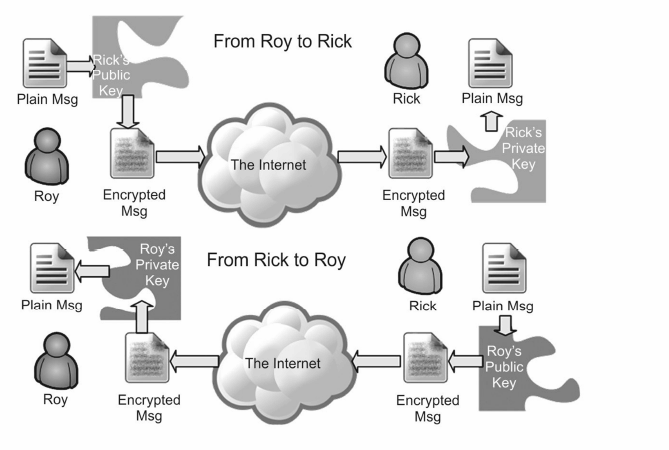
The correct way to describe the main concepts showing by the figure is:
- A. If someone wants to send a private message, he gets the secret key (directly from the receiver in an e-mail) and use it to encrypt the message. For a message back to the sender, the receiver grab his secret key and encrypt with that. So all the encrypting is done with the secret keys, and all the decrypting is done with the corresponding public keys.
- B. There's one major benefit to doing encryption this way: there is no need to send anything secret over an insecure channel. The public key goes out to the world, but it's not secret and it doesn't need to be. The private key can stay safe on a personal computer, where it was generated.
- C. The secret key cryptography method, also called asymmetric encryption, employs a secret key for both encryption and decryption. The sender uses the key to encrypt the plain message and sends the encrypted message to the receiver. The receiver applies the same key to decrypt the message and recover the plain message.
- D. Hash algorithms are typically used to provide a digital fingerprint of a plain message contents, often used to ensure that the message has been altered by an intruder or virus. Using public and secret keys, hash functions, then, provide a measure of the corruption of a message.
- E. The public key cryptography method, also called symmetric encryption, employs two keys that are mathematically related although knowledge of one key does not allow someone to easily determine the other key. One key is used to encrypt the plain message and the other key is used to decrypt the cipher text.
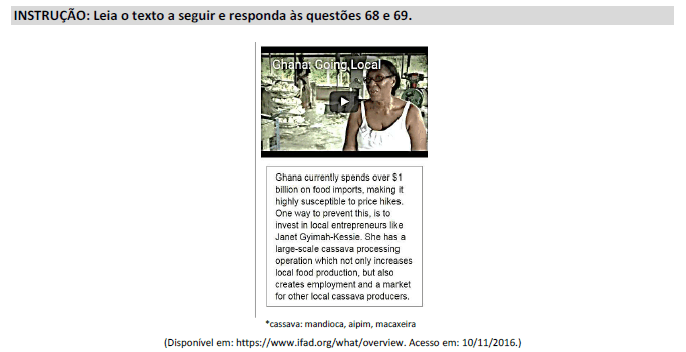 No texto, o pronome relativo which refere-se a
No texto, o pronome relativo which refere-se a
- A. entrepreneurs like Janet Gyimah-Kessie.
- B. a large-scale processing operation.
- C. local food production.
- D. local cassava producers.
Língua Inglesa - Gramática - Instituto Nosso Rumo de Educação e Desenvolvimento Social (NOSSO RUMO) - 2017
Read the extract below.
Thiels fight involves investing millions in biotechnology and artificial intelligence in what he has called the immortality project. His investment firm Thiel Capital has, according to Inc, expressed an interest in a company called Ambrosia, which is running a trial where individuals can pay $8,000 to receive a blood transfusion from a teenager in the hope that it will restore some youthful vigour.
The highlighted relative pronoun which above refers to
- A. the immortality Project.
- B. Thiel.
- C. biotechnology and artificial intelligence.
- D. Ambrosia.
- E. his investment firm.
Língua Inglesa - Gramática - Instituto Nosso Rumo de Educação e Desenvolvimento Social (NOSSO RUMO) - 2017
Choose the alternative that correctly fills the blank spaces in the sentences below.
Welcome! ______ is my new house. _____ houses are bigger than ______ we saw yesteday I parked my car near _____ tree. Can you see it?
- A. That/ Those/ these/ this
- B. This/ These/ those/ that
- C. These/ This/ those/ that
- D. These/ Those/ this/ that
- E. That/ This/ these/ those
Língua Inglesa - Gramática - Instituto Nosso Rumo de Educação e Desenvolvimento Social (NOSSO RUMO) - 2017
Choose the alternative that correctly fills the blank spaces in the sentences below.
I downloaded the file _____ that website.
Francis will be back ____ 5 oclock.
Susan goes to school ____ bus.
He will pay the water bill ___ Friday.
- A. for/ at/ in/ at
- B. to/ on/ by/ in
- C. from/ by/ by/ on
- D. from/ at/ on/ to
- E. to/ at/ from/ at
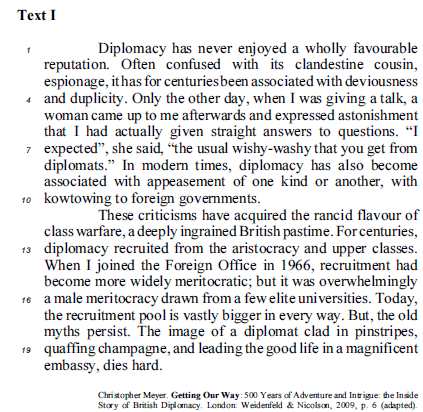
Considering the grammatical and semantic aspects of text I, decide whether the following items are right (C) or wrong (E).
The excerpt that you get from diplomats (l. 7 and 8) could be correctly replaced by which one gets from diplomats without this changing the meaning of the text.- C. Certo
- E. Errado
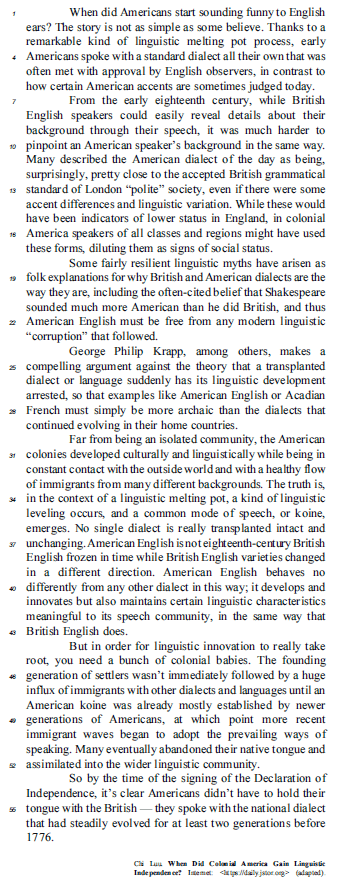
Considering the grammatical and semantic aspects of text IV, decide whether the following items are right (C) or wrong (E).
The expression a bunch of (l.45) could be replaced by a cluster of without altering the meaning of the passage.- C. Certo
- E. Errado
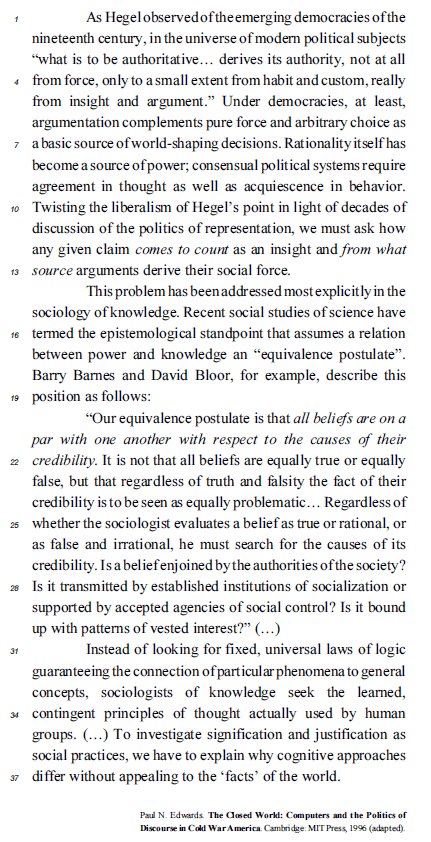
Considering the grammatical and semantic aspects of text V, decide whether the following items are right (C) or wrong (E).
The word contingent (l.34) is synonymous with necessary.- C. Certo
- E. Errado


